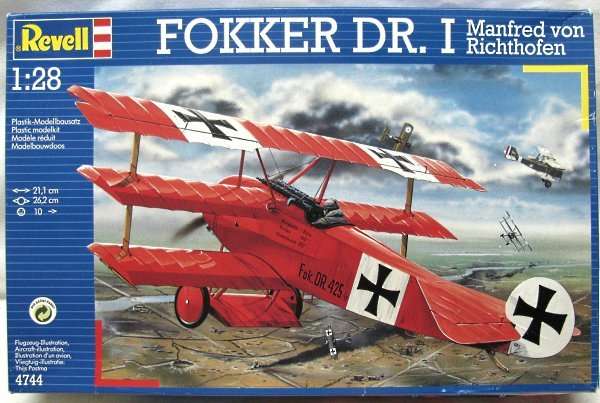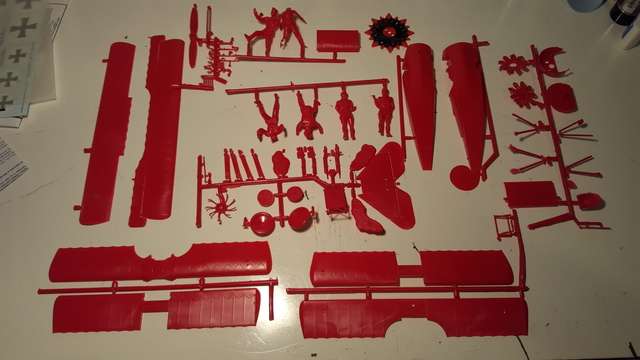I have been looking forward to this kit in my stach for a while. Anyway I’m starting Manfred’s Fokker Dr1 Tri. This is an old mold with some flashing. I will be painting it in his famous red rather the pre-red 3 tone green of Jasta 11.


Steve
I have been looking forward to this kit in my stach for a while. Anyway I’m starting Manfred’s Fokker Dr1 Tri. This is an old mold with some flashing. I will be painting it in his famous red rather the pre-red 3 tone green of Jasta 11.


Steve
MC
That is a rebox of the old mold going back to 1960 or so and it’s actually a pretty decent kit with the help of some scratch work and pe. I got mine a while back at a garage sale for a buck or so if I correctly recall. It had a decal set from an IPMS convention issue from the 60’s or 70’s and they were still good.
I completely scratched out the pit and added pe details from Tom’s Modelworks. FSM purchased the article but it hasn’t been published and have no clue when it will be. It was partially built so I could not get into some areas to improve the detail cause I was afraid of damaging the fragile plastic.
Here are a couple of pictures of mine. As you can see, Tom’s pe really dresses up the twin Spandaus over the stock ones.


I will be following your thread religiously during your build. I’m looking forward to this one! Also, nice build PlasticJunkie.
Toshi
Thanks Toshi.
Steve
Forgot to mention about the different shaped ailerons. I don’t know how deep you are going with the build but here is a quote from one of Stephen Lawson’s posts explaining the odd shaped ailerons and serial number range.
"Only approximately 15-18 of the initial production batch had the odd aileron set up. This included Dr.I 135/17 -144/17 for sure. After the Idflieg order to have them enlarged (among other things including factory spec top wings) the first machines to be refitted went through the assembly line with one of the older type ailerons still in use. See Alex Imrie’s book “The Fokker Triplane.”
Now why would Revell match this? The schematic for this and the old 1/72 scale kit were drawn up by Revell of Great Britain in the early 1950’s. The plans they used were from “Flight” magazine and were of a machine that had been brought down on Jan. 13, 1918. Fokker Dr.I 144/17 was one of the odd aileron machines. It was studied and then had half of its fabric covering removed and was displayed along with other captured German machines in Ilsington at the Agricultural Hall for the benefit of the RAF hospital. A penny would get you a walk through in 1918."
More proof that not all really old kits were junk. Very nice!
I have been looking at this kit for some time, will be watcing ![]() As a matter of interest, do you know what the reason is for the “cutouts” in the mid wing at the wingroot? So that the pilot could actually see where he was going when on the ground
As a matter of interest, do you know what the reason is for the “cutouts” in the mid wing at the wingroot? So that the pilot could actually see where he was going when on the ground ![]() Theuns
Theuns
Thanks Don. I also have the old Camel and it too makes an impressive model , again with scratchwork and pe updates.
Werner Voss nice build. I made this kit so many times in the 60’s
This is such a cool plane, looks kinda unstable though. I understand that while not as fast as most of the allied fighters (too much drag) it could really turn on a dime (a lot of lift). PJ, you are so good at wood recreation, I should send you my prop to paint [;)]. Just kidding, I need to learn myself. That paint job looks very convincing. Looks like it was painted with a dope wash of varying shades of green. I’ll look into a PE set, maybe I can find one on the cheap on eB. Thank you everyone for your interest.
PS.
Thanks Theuns for that info. I kina wondered what that was for.
The reason for the 3 wings was to increace wing area therby making for a lower wingloading, this equals a much better climb rate. You do not want to simply increace wingspan as this reduces roll rate. Because of the rotary engine’s massive gyroscopic effect it wouls not react like a normal plane, if you could master it , it was extremely agile. Just like Sopwith Camel, you used the same direction of rudder offset to turn left and right! These rotaries also dod not have a norma throttle, you had selector switches that turned off some of the spark plus thereby decreacing power. That is why they “blipped” the engine for landing. Theuns
I just ordered the cockpit and gun detail set from Tom’s Model Works. It should be here soon.
Thanks Crown but actually it was not Voss’s machine. This machine is Dr-1 183/17 Flown by Hasso von Wedel of Jasta 14. Easily confused with Voss’s mount from the top picture I posted.

The streaked scheme is olive green streaked over unbleached linnen at different angles per documentation.
still looks great
Steve
Not a problem if you want the prop done. I can PM you my mailing address. I will be more than glad to grain the prop for you.

Hmmm [^o)] That is tempting. There’s no way I could do as good a job. I’ll give it a try on a scrap piece and if I just can’t get it, Ill PM ya. I studied your discription on your guillotine last year and have tried it a few times with terrable results. [*-)]
Thanks again Crown.
Steve
Not a problem. Shoot me a pm if things don’t work out.
I was eyeballing this kit yesterday on the web. I’m keen to see how this turns out.
BK
It is sometimes said that these engines did not have a throttle at all- they did, it was just that carburetor design was primitive, and the throttle was only useful for gross changes in power. This was true of all engines of that era, not just rotaries.
In early automobiles the same problem existed. The throttle was just for going between idle and drive, for example, with fine speed control done by changing spark advance. It took a few decades for carburetors for cars to develop adequate throttle response. Such response was less important for aircraft, so aircraft engines had poor throttle response for half a century!
Nice! Look forward to seeing this one built.
Plasticjunkie> And I look forward to seeing the article someday!
Meanwhile, you can never have too many Dr.1s. [H]

However, I question the accuracy of some of the build details! [:O]
But they fly well…

Great pic GAF, where was that at? I see a D5 slipped in there.
We have one at the local museum. I may have to go and get some more pics.


